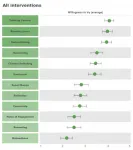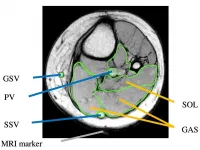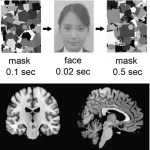(Press-News.org) The internet seems like the place to go to get into fights. Whether they're with a family member or a complete stranger, these arguments have the potential to destroy important relationships and consume a lot of emotional energy.
Researchers at the University of Washington worked with almost 260 people to understand these disagreements and to develop potential design interventions that could make these discussions more productive and centered around relationship-building. The team published these findings this April in the latest issue of the Proceedings of the ACM in Human Computer Interaction Computer-Supported Cooperative Work.
"Despite the fact that online spaces are often described as toxic and polarizing, what stood out to me is that people, surprisingly, want to have difficult conversations online," said lead author Amanda Baughan, a UW doctoral student in the Paul G. Allen School of Computer Science & Engineering. "It was really interesting to see that people are not having the conversations they want to have on online platforms. It pointed to a big opportunity to design to support more constructive online conflict."
In general, the team said, technology has a way of driving users' behaviors, such as logging onto apps at odd times to avoid people or deleting enjoyable apps to avoid spending too much time on them. The researchers were interested in the opposite: how to make technology respond to people's behaviors and desires, such as to strengthen relationships or have productive discussions.
"Currently many of the designed features that users leverage during an argument support a no-road-back approach to disagreement -- if you don't like someone's content, you can unfollow, unfriend or block them. All of those things cut off relationships instead of helping people repair them or find common ground," said senior author Alexis Hiniker, an assistant professor in the UW Information School. "So we were really driven by the question of how do we help people have hard conversations online without destroying their relationships?"
The researchers did their study in three parts. First, they interviewed 22 adults from the Seattle area about what social media platforms they used and whether they felt like they could talk about challenging topics. The team also asked participants to brainstorm potential ways that these platforms could help people have more productive conversations.
Then the team conducted a larger survey of 137 Americans ranging from 18 to 64 years old with political leanings that ranged from extremely conservative to extremely liberal. These participants were asked to report what social media platforms they used, how many hours per week they used them and if they had had an argument on these platforms. Participants then scored each platform for whether they felt like it enabled discussions of controversial topics. Participants were also asked to describe the most recent argument they had had, including details about what it was about and whom they argued with.
Many participants shared that they tried to avoid online arguments, citing a lack of nuance or space for discussing controversial subjects. But participants also noted wanting to have discussions, especially with family and close friends, about topics including politics, ethics, religion, race and other personal details.
When participants did have difficult conversations online, people tended to prefer text-based platforms, such as Twitter, WhatsApp or Facebook, over image-based platforms, such as YouTube, Snapchat and Instagram.
Participants also emphasized a preference for having these discussions in private one-on-one chats, such as WhatsApp or Facebook Messenger, over a more comment-heavy, public platform.
"It was not surprising to see that people are having a lot of arguments on the more private and text-based platforms," Baughan said. "That really replicates what we do offline: We would pull someone aside to have a private conversation to resolve a conflict."
Using information from the first two surveys, the team developed 12 potential technological design interventions that could support users when having hard conversations. The researchers created storyboards that illustrated each intervention and asked 98 new participants, ranging from 22 to 65 years old, to evaluate the interventions.
The most popular ideas included:
Democratizing
In this intervention, community members use reactions, such as upvoting, to boost constructive comments or content.
"This moves us away from the loudest voice drowning out everyone else and elevates the larger, quieter base of people," Hiniker said.
Humanizing
The goal of this intervention is to remind people that they are interacting with other people. Some ideas include: preventing users from being anonymous, increasing the size of users' profile pictures, or providing more details about users, such as identity, background or mood.
Channel switching
This intervention provides users with the ability to move a conversation to a private space.
"I envision this intervention as the platform saying: 'Would you like to move this conversation offline?' Or maybe it has some sort of button, where you can quickly say: 'OK, let's go away from the comments section and into a private chat,'" Baughan said. "That could help show more respect for the relationship, because it doesn't become this public arena of who's going to win this fight. It becomes more about trying to reach an understanding."
The least popular idea:
Biofeedback
This intervention uses biological feedback, such as a user's heart rate, to provide context about how someone is currently feeling.
"People would tell us: 'I don't want to share a lot of personal information about my internal state. But I would like to have a lot of personal information about my conversational partner's internal state,'" Hiniker said. "That was one of the design paradoxes we saw."
The next step for this research would be to start deploying some of these interventions to see how well they help or hurt online conversations in the wild, the team said. But first, social media companies should take a step back and think about the purpose of the interaction space they've created and whether their current platforms are meeting those goals.
"I would love to see technology help prompt people to slow down when it comes to things like knee-jerk emotional reactions," Baughan said. "It could ask people to reflect: Is this a good use of my time? How much do I value this relationship with this person? Do I feel like it's safe to engage in this conversation? And if a conversation happens in a public space, it could suggest taking it offline or going to a private space."
INFORMATION:
Justin Petelka, a UW doctoral student in information science; Amulya Paramasivam, a UW undergraduate student majoring in human centered design and engineering; and Catherine Yoo, Jack Lo, Shiyue Wang and Ashley Zhou, who completed this research as undergraduate students at the UW, are also co-authors on this paper. This research was funded by Facebook.
For more information, contact Baughan at baughan@cs.washington.edu and Hiniker at alexisr@uw.edu.
Chronic lower-limb edema (CLE) -- the permanent accumulation of fluid in the leg -- often occurs in elderly people. The condition leads to various physical and mental problems, including difficulty in walking or moving, fatigue and anxiety. One cause of CLE is the lack of physical activity, which is associated with a decrease in muscle pump action. The latter refers to the leg muscle's acting as a blood pump: when contracted, the muscle squeezes veins together, forcing blood to flow. The question whether muscle pump action systematically changes with age has not been thoroughly investigated; now, Junko Sugama from Kanazawa University and colleagues have addressed this issue. In addition, they studied how leg posture affects muscle pump action.
For their study, Sugama ...
Osaka, Japan - As humans, we each have a powerful ability to easily recognize our own face. But now, researchers from Japan have uncovered new information about how our cognitive systems enable us to distinguish our own face from those of others, even when the information is presented subliminally.
In a study published this month in Cerebral Cortex, researchers from Osaka University have revealed that a central element of the dopamine reward pathway in the brain was activated when participants were subliminally shown images of their face. This provides new clues regarding the underlying processes of the brain involved in self-facial recognition.
When we are ...
Southeastern Tibet is one of the most glaciated regions on the Tibetan Plateau both at present and during the Quaternary. Numerical dating of glacial deposits has allowed the establishment of a provisional chronology of Quaternary glacial fluctuations in this region, with the oldest glaciation (Guxiang Glaciation) occurring in marine oxygen isotope stage 6 (MIS-6). However, glaciations predating MIS-6 have been identified at many locations on the Tibetan Plateau and its surrounding mountains, posing the question: as a major glaciation center both at present and during the Quaternary, did a glaciation prior to MIS-6 ever occur in southeastern Tibet?
Zhou et al. (2021) provide evidence for a glacier advance in the Bodui Zangbo River ...
Japan -- Next to cat videos, watching small and cuddly rabbits is probably one of the most popular internet pastimes. Plus they appear in literature as well as in traditional folklore spanning numerous cultures, thanks likely to the fact that rabbits reside on every continent except Antarctica.
Yet despite their ubiquity, lagomorphs -- including rabbits, hares, and pikas -- are rather limited in their size diversity. Compare this to their evolutionary sisters, the rodents, which vary in size from the four-gram pygmy mouse to capybaras weighing as much as 50 kilograms.
So why don't we see rabbits rivaling the sizes of horses?
To answer this question, a research team ...
With its more than 40 million articles in 301 different languages, Wikipedia is one of the largest human collaboration efforts in history. One of the main pillars on which this wish to bring together the sum of all knowledge is based is the achievement of a neutral space. However, several studies suggest that the site suffers from a persistent gender bias as regards both content and the composition of its community. An analysis of the gender gap in the Spanish-language version of Wikipedia by an interdisciplinary team at the UOC has revealed that only 11.6% of its registered editors are women.
According to the new study, which has been published in the journal PLOS ONE, the difference could be partially due to female editors being less ...
Over the last 200 years, researchers have worked towards understanding the global distribution of species and ecosystems. But so far even the basic knowledge on the global geography of genetic diversity was limited.
That now changes with a recent paper from Globe Institute. Professor David Nogues Bravo and his team has spent the last eight years combining data from scientific gene banks with scenarios of future climate and land-use change. The result is the first ever global assessment of how it will impact the genetic diversity of mammals, e.g. when tropical forests are converted to agricultural land.
'Our study ...
Singapore, 19 April, 2021 - Researchers at the Future Urban Mobility (FM) Interdisciplinary Research Group (IRG) at Singapore-MIT Alliance for Research and Technology (SMART), MIT's research enterprise in Singapore, have created a synthetic framework known as theory-based residual neural network (TB-ResNet), which combines discrete choice models (DCMs) and deep neural networks (DNNs), also known as deep learning, to improve individual decision-making analysis used in travel behaviour research.
In this research paper, Theory-based residual neural networks: A synergy of discrete choice models and deep neural networks, ...
The production of nanomaterials involves self-assembly processes of functionalized (organic) molecules on inorganic surfaces. This combination of organic and inorganic components is essential for applications in organic electronics and other areas of nanotechnology.
Until now, certain desired surface properties were often achieved on a trial-and-error basis. Molecules were chemically modified until the best result for the desired surface property was found. However, the processes controlling the self-assembly of molecules at interfaces are so complex ...
Liquid Crystals (LC) are widely deployed in display technology and optical fibres. From smartphones in your pockets to large screen TVs, LCs are everywhere, as this special state of matter has been found in colorful soap bubbles as well as certain living tissues.
But LCs are by no means limited to use in gadgets or electronic devices. For quite some time, scientists have been studying the possibility of creating "active nematics", a particular class of active LCs, which consist of self-driven units capable of converting chemical or other forms of energy into motion. When administered the proper stimuli, scientists have found that they can generate a predictable response from different LCs, which allows for design of smart, multifunctional ...
A team of researchers from the Hebrew University of Jerusalem has proven the linkages between ultra-processed foods and reduced bone quality, unveiling the damage of these foods particularly for younger children in their developing years. The study, led by Professor Efrat Monsonego-Ornan and Dr. Janna Zaretsky from the Department of Biochemistry, Food Science and Nutrition at the University's Faculty of Agriculture, was published in the journal Bone Research and serves as the first comprehensive study of the effect of widely-available food products on skeleton development.
Ultra-processed foods--aka, junk food--are ...








